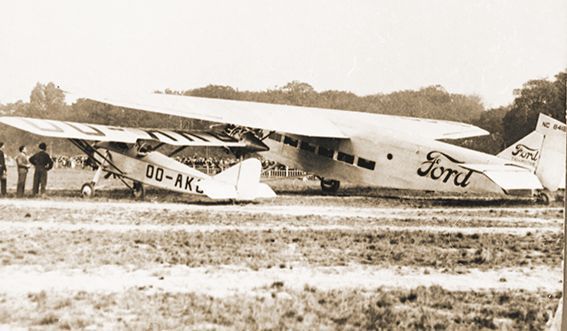
On September 15, 1929, the Ford Tri-Motor with Henry Ford lands at the Antwerp airfield. (coll. Dirk Buytaert)
A new airport...
With the end of the activities at the "Wilrijckse Plein", our pioneers had to move to other places. However, it would take until 1923 before Antwerp could once again have its own airfield. Fortunately, a number of "die-hards" managed to convince the authorities in Brussels of the usefulness of such an infrastructure.
Fortunately, in the history of Antwerp there have always been citizens who, when things went a bit bad, did not give up. Convinced of the usefulness and possibilities of aviation, Jan Olieslagers and the Van Migem brothers managed to convince the Mayor and Aldermen to negotiate with the Belgian State about a new airfield. In 1922, the necessary expropriations of a site of 80 hectares. in Deurne-Zuid have been done and the leveling of the grounds and the construction of a metal aircraft hangar can begin.
As an airport building, four old freight wagons of the railways were parked on the edge of the site. One of them served as an “Aérogare” or air station and was used as an office by the newly appointed airport commander Scheldeman.
Coincidence or not: on May 29, 1924 - Ascension Day - the new airfield was officially inaugurated with, of course, a first air meeting and this under the high patronage of King Albert I, an aviation fan in heart and soul. The weather was beautiful and thousands came to marvel at the daredevilry. The street that gave access to the new airport was appropriately named Jan Olieslagersstraat.
Photo captions (top-left to bottom-right)
- The first airport building of the Antwerp airport, one of four old freight wagons of the Belgian railways. (coll. Dirk Buytaert)
- Soon the railway wagon was replaced by a somewhat more solid chalet, equipped with offices. The freight wagons continued to be used as a warehouse. (coll. Dirk Buytaert)
- Henry Ford, who visited his European factories, was received in Antwerp in an appropriate manner by AAC chairman Jan Olieslagers. (coll. Dirk Buytaert)
- One of the Sabena Fokker F.VIIs that were used on the air connection with Brussels and Ostend. (coll. Dirk Buytaert)
- An early 'selfie' after a nice first flight. (coll. Dirk Buytaert)
- One of the many meetings that always attracted a lot of interest in Antwerp in the 1920s. (coll. Dirk Buytaert)






